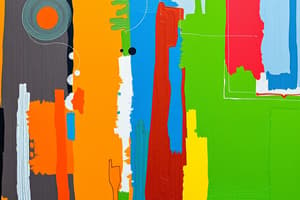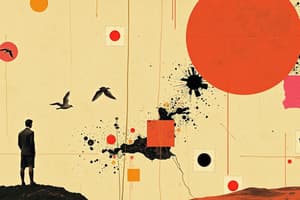Podcast
Questions and Answers
What is a line in visual arts?
What is a line in visual arts?
A series of connected points.
Define space in the context of visual arts.
Define space in the context of visual arts.
Area occupied by an object.
What is a shape?
What is a shape?
Area enclosed by lines.
What does form refer to in visual arts?
What does form refer to in visual arts?
What are the components of color?
What are the components of color?
Which of the following is NOT a color scheme?
Which of the following is NOT a color scheme?
What is monochromatic color scheme?
What is monochromatic color scheme?
What is texture in visual arts?
What is texture in visual arts?
What are the types of space perspective?
What are the types of space perspective?
Name different kinds of lines.
Name different kinds of lines.
List different kinds of shapes.
List different kinds of shapes.
Match the following principles of art with their definitions:
Match the following principles of art with their definitions:
Flashcards are hidden until you start studying
Study Notes
Visual Elements of Arts
- Visual arts consist of key elements that include line, space, shape, form, color, texture, and time and motion.
Line
- Defined as a series of connected points, lines are foundational in creating shapes and guiding the viewer's eye.
Space
- Refers to the area that an object occupies within a composition, influencing how elements are perceived.
Shape
- Represents an area that is enclosed by lines, categorized into geometric, organic, and abstract types.
Form
- Describes a three-dimensional figure, adding depth to visual arts.
Color
- Hue: The basic or pure color that forms the basis for all other colors.
- Value: Indicates the lightness or darkness of a color, affecting mood and depth.
- Saturation: Refers to the brightness or dullness of a color, impacting intensity.
- Color Wheel: A visual arrangement of colors featuring primary, secondary, and tertiary categories.
- Monochromatic: Involves using various gradients of the same hue to create a cohesive look.
- Analogous: Features four colors that are adjacent on the color wheel, promoting harmony.
- Complementary: Involves pairing a color with its complement to create contrast.
- Split Complementary: Utilizes a trio of colors, including one color and two adjacent to its complement.
- Triadic: Involves three colors evenly spaced apart on the color wheel for vibrant compositions.
- Tetradic: Known as the double complementary color scheme, combining two pairs of complementary colors.
Texture
- Actual Texture: Tangible textures that can be felt or touched in a work of art.
- Implied Texture: Visual textures that suggest a feeling or sensation without physical contact.
Time and Motion
- Incorporates movement within visual arts, which can be actual or an illusion presented through dynamic compositions.
Properties of Color
- Main properties of color include hue, value, and saturation, which influence aesthetics.
Color Schemes
- Various strategies for color use in artworks include monochromatic, analogous, complementary, split complementary, triadic, and tetradic schemes.
Kinds of Lines
- Lines can be categorized as curved, dotted, broken, diagonal, horizontal, or vertical, each conveying different emotions and meanings.
Types of Texture
- Textures are classified into actual (tangible) and implied (visual), contributing to the overall experience of the artwork.
Types of Space Perspective
- Two main types of space perspective are linear perspective (creating depth through convergence) and atmospheric perspective (enhancing depth through color fading).
Movements in Visual Arts
- Movement can be depicted as an illusion or actual motion, engaging viewers and guiding their observation.
Different Kinds of Shape
- Shapes are classified into geometric (precise forms), organic (natural forms), and abstract (non-representational forms).
Principles of Art
- The principles of design include proportion (size relationships), harmony (unity), variety (diversity), movement (illusion of motion), rhythm (repetition), balance (distribution), and emphasis (focal points).
Proportion
- Refers to the relationship and scale between different elements within a composition, affecting the harmony of the piece.
Harmony
- Achieved when various elements work together to create a cohesive artwork.
Variety
- Introduces diversity within art, enhancing interest and engagement.
Movement
- Refers to the dynamic elements within a piece that guide the viewer's eye and create a sense of action.
Rhythm
- Created through the repetition of elements, providing a sense of flow within the artwork.
Balance
- Ensures an even distribution of visual weight, creating stability in a composition.
Emphasis
- Highlights certain elements within a work, providing greater importance or focus, guiding viewer attention.
Studying That Suits You
Use AI to generate personalized quizzes and flashcards to suit your learning preferences.




